Knee Pain
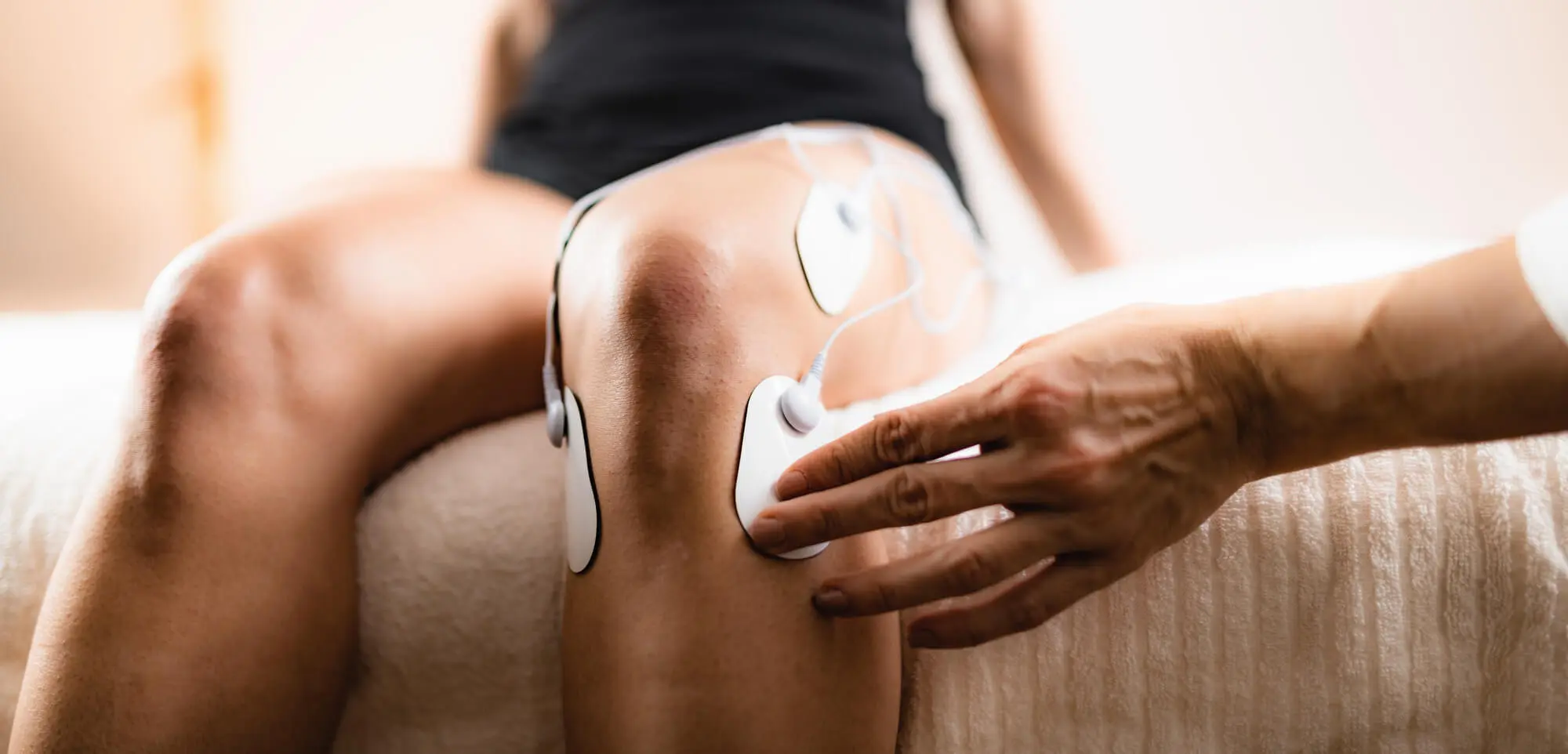
A Comprehensive Guide On Electrical Stimulation Therapy For Knee Pain
Read More
May 16, 2023
Chronic knee pain affects over 25% of the population, making it one of the most widespread musculoskeletal disorders worldwide. And, given how much we rely on our knees for everyday activities, it is easy to estimate the extent of the impact that this condition may have on a person’s life.
From dealing with recurring pain and reduced mobility to facing the challenges associated with unmanageable care costs and declining productivity, chronic knee pain can certainly be debilitating. To make things worse, patients with a chronic or degenerative knee condition have two, equally undesirable options: relying on pain medications or undergoing surgery.
However, approaches such as electrical stimulation therapy are now offering a non-pharmaceutical and non-invasive alternative to treat knee pain. Let’s look at how these therapies work and how effective they are below.
Electrical stimulation – also known as neuromodulation or E-stim – is a pain management approach that uses electricity to decrease knee pain and discomfort. During the treatment, mild pulses of electrical current are delivered to the area affected by pain with the use of sticky pads.
The pulses of electricity will produce a cascade of effects, including:
Being non-drug, non-surgical, and non-pharmaceutical, this approach can be used by a large percentage of the population with minimal risks.
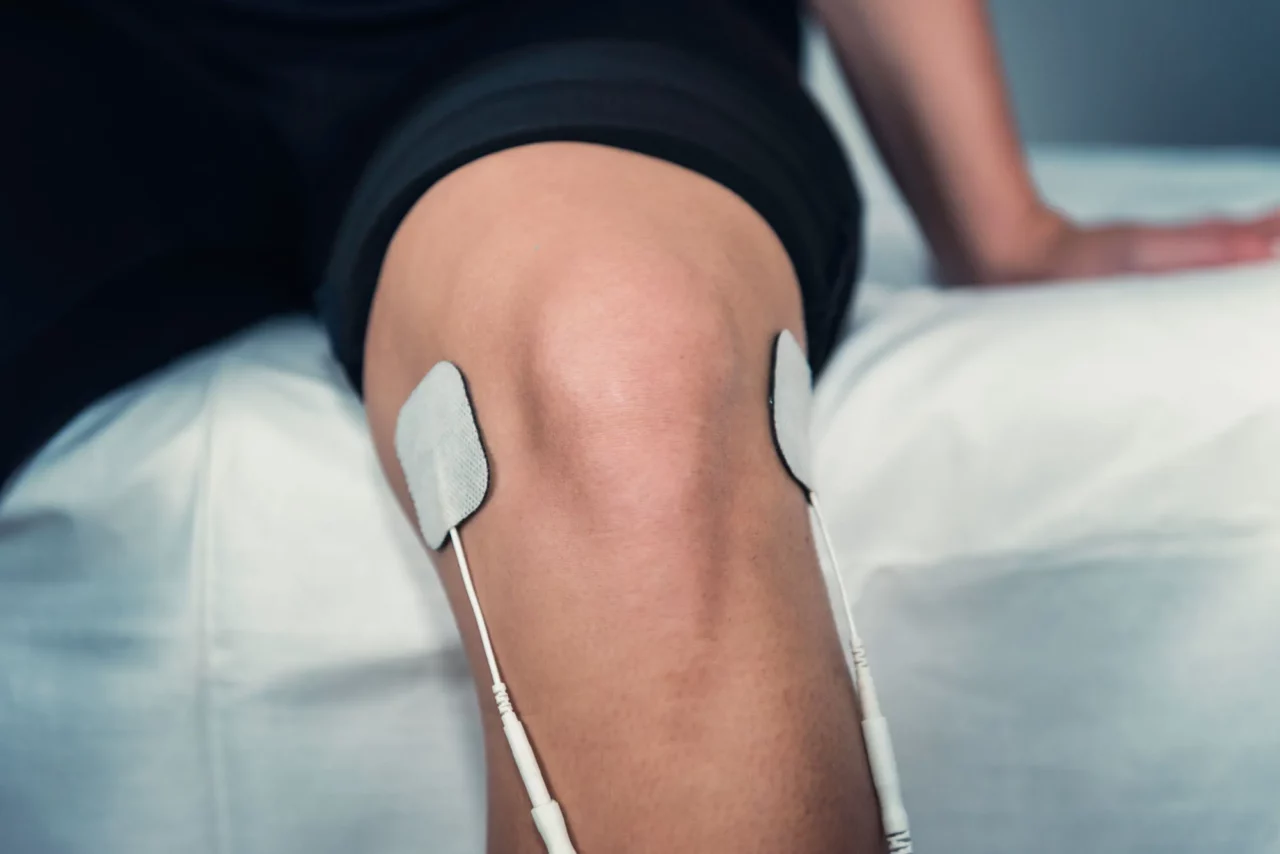
With the guidance of a specialized healthcare professional, electrical stimulation can be used to address a wide range of conditions that cause knee pain. The most common ones are:
With over 303 million cases worldwide, osteoarthritis is the leading cause of knee pain among older adults. This degenerative condition causes the breakdown of the joint’s components, thus leading to pain, reduced mobility, and in severe cases, disability.
Some other factors that increase your risk of suffering from knee pain later in life include obesity, a sedentary lifestyle, and overuse.
Given the permanent or degenerative nature of most conditions affecting the knee, electrical stimulation therapy represents a more sustainable pain management approach compared to pain medications or surgery.
Electrical stimulation therapies are often used as part of a more comprehensive physical therapy and pain management program, usually in combination with other therapies.
Below, we’ll look at the different types of e-stim therapies and when they should be used to treat knee pain.
Transcutaneous electrical nerve stimulation (TENS) is one of the most popular types of neuromodulation therapy. TENS units are today available as over-the-counter devices and allow for the self-administration of the treatment.
Using TENS units for knee pain may provide relief from pain by interrupting or altering the pain signals traveling from damaged tissues in the knee joint to the brain.
TENS is performed using a portable, battery-operated device attached to a set of electrodes (sticky pads) that are placed around the knee joint. Selecting the right setting, the device will send mild pulses of electricity through the skin and the joint’s components.
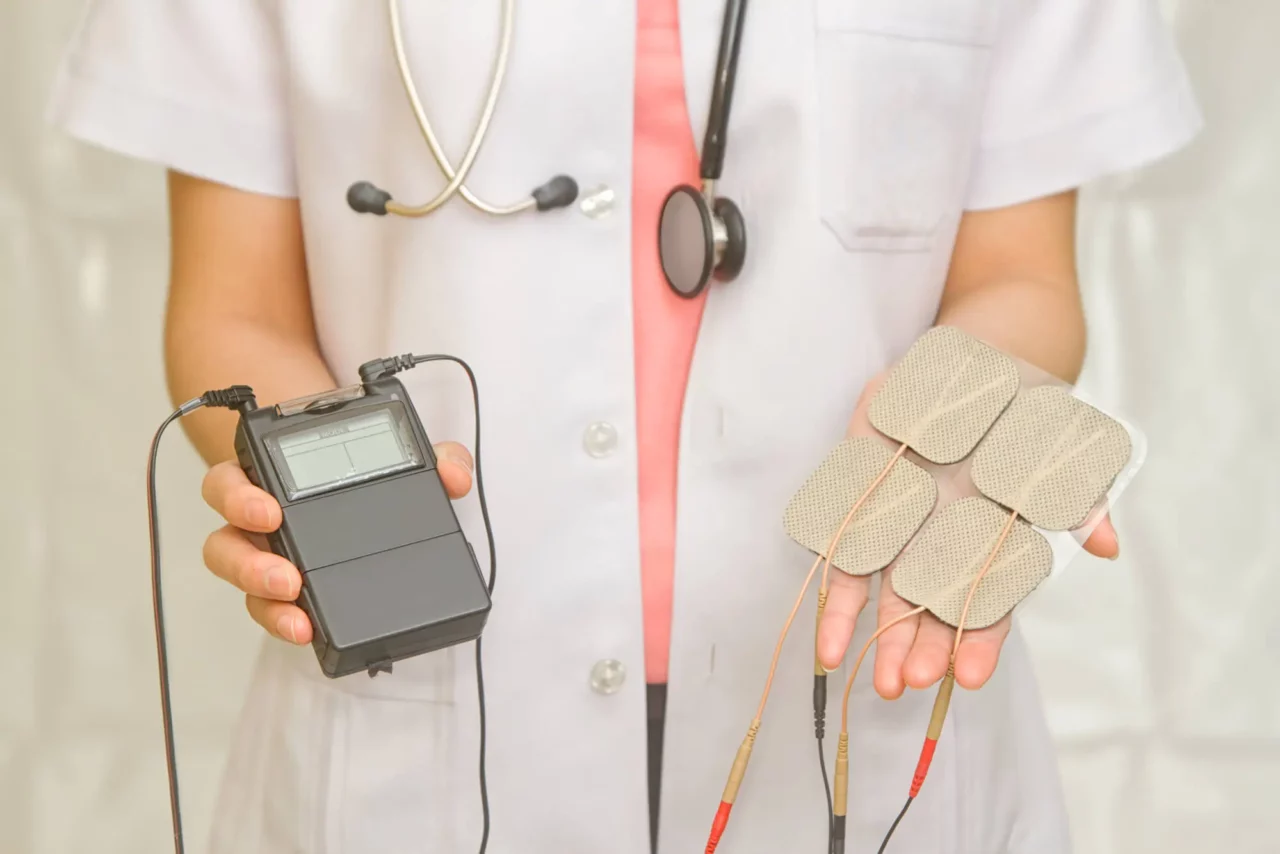
The surge of electrical activity in the area will temporarily stop pain signals from reaching the brain and spinal cord, where they should be processed. This action, coupled with the release of endorphins and a reduction of inflammation, can ease painful sensations.
Depending on your TENS device, you may be able to choose one of many different settings and adjust the rate at which the pulses are delivered (frequency).
This kind of e-stim therapy is the most commonly used one to address both acute (short-term) and chronic (long-term) knee pain.
Studies conducted in 2000 show that TENS can be used in the management and modulation of knee pain deriving from osteoarthritis. In a review published in 2015 by Cochrane, using transcutaneous electrical nerve stimulation reduced pain intensity by 50% in half of the patients studied.
However, not all studies have reached the same conclusions. According to a randomized controlled trial published in 2015, TENS improved subjective measures, such as pain intensity, functional abilities, and quality of life. However, a clinical trial published in 2021 in the Osteoarthritis and Cartilage Journal shows that TENS may not improve osteoarthritis pain.
Neuromuscular electrical stimulation (NMES) is a procedure used to deliver mild pulses of electrical current to weak or paralyzed muscles. The electrical pulses help the muscles contract properly, which improves muscle strength, promotes blood circulation, and relieves muscle spasms.
This therapy works by stimulating the nerve endings located within the muscles. These nerves are part of the peripheral nervous system – or the nerves located outside the brain and the spinal cord – and are responsible for transmitting signals relating to muscle movements to the brain.
NMES works similarly to TENS units. Electrodes attached to a battery-operated device are applied to the areas around the knee. Mild pulses of electrical current are then delivered to the muscles that support the knee joint to re-educate the muscles to contract properly.
During an NMES therapy session, the electrodes are attached to the knee while you are performing everyday tasks, such as walking. As your leg moves, the electrical stimulation turns on, thus instructing the muscles to contract when they are supposed to contract. Vice-versa, the stimulation turns off when your muscles are supposed to relax or rest.
This form of therapy may help people regain their knee function after surgery (i.e.: total knee arthroplasty) or a long period of immobilization following an injury.
NMES may also be used in people with arthritis to strengthen the muscles surrounding a weakened knee joint or to prevent a loss of muscle mass that may occur due to disuse.
Studies show promising results that NMES can help patients regain their muscle function.
According to a 2019 study published by Frontiers, re-educating muscles to contract properly can play a role in the management and prevention of chronic conditions, especially in individuals who are unable to practice physical exercise.
The same study suggests NMES can prevent muscle atrophy in patients with reduced mobility, help maintain muscle strength, and support recovery from invasive surgeries such as total knee arthroplasty.
A 2012 study also shows that undergoing NMES therapy for 8 weeks helps patients with knee osteoarthritis improve their quadriceps strength and overall health.
Interferential Current Therapy (ICT) is a type of electrical stimulation therapy used to modulate pain and improve blood circulation to damaged tissues.
This double action ensures that the pulses can reach deeper into the tissue and inhibit the transmission of pain signals to the brain. ICT may also be more effective in boosting blood circulation and triggering the release of pain-relieving hormones like endorphins.
Although ICT is similar to TENS in many ways, this kind of therapy differs in that it delivers two pulses of electricity at two different medium frequencies. The pulses alternate throughout a single session and can be adjusted and varied to address different types of painful tissues.
During an ICT session, one of the pulses is kept at a constant frequency (usually 2000 Hz, 4000 Hz, or 6000 Hz), while the other one varies within a range of frequencies. This prevents your body from becoming used to the current and improves this therapy’s efficiency.
ICT is often recommended to patients with knee osteoarthritis because of the longer-lasting pain-relieving action, but it can also be used in the treatment of sprains, strains, and joint damage.
A systematic review conducted in 2015 on the efficacy of various electrical stimulation therapies suggests that ICT is the most prominent pain management method for knee osteoarthritis.
Additionally, a 2021 study on the analgesic effects of ICT shows that this therapy can efficiently relieve pain in people with knee osteoarthritis and post-operative knee pain. The same study highlights that the frequencies selected during the ICT therapy did not have an impact on its analgesic effects.
Electronic Muscle Stimulation (EMS) is sometimes referred to as Russian stimulation. This therapy works similarly to Neuromuscular Electrical Stimulation and aims to re-educate the muscles to contract properly during movement.
This aids the maintenance of muscle mass and prevents muscle atrophy in people with degenerative knee conditions, limited mobility, temporary or permanent immobilization, and disability.
EMS is similar to NMES: it delivers electrical current to the nerve endings within the muscles to trigger contractions. However, EMS uses intermittent and alternating medium-frequency electrical pulses (Russian Current), which help create more powerful or forceful movements in muscles that are otherwise unable to contract.
This therapy may be used to help strengthen the muscle mass around a weakened knee joint, which can happen due to osteoarthritis. Although EMS is sometimes used in physical therapy and weight loss programs, it is mainly recommended to relieve muscle spasms, prevent muscle loss, and retrain muscles to contract properly.
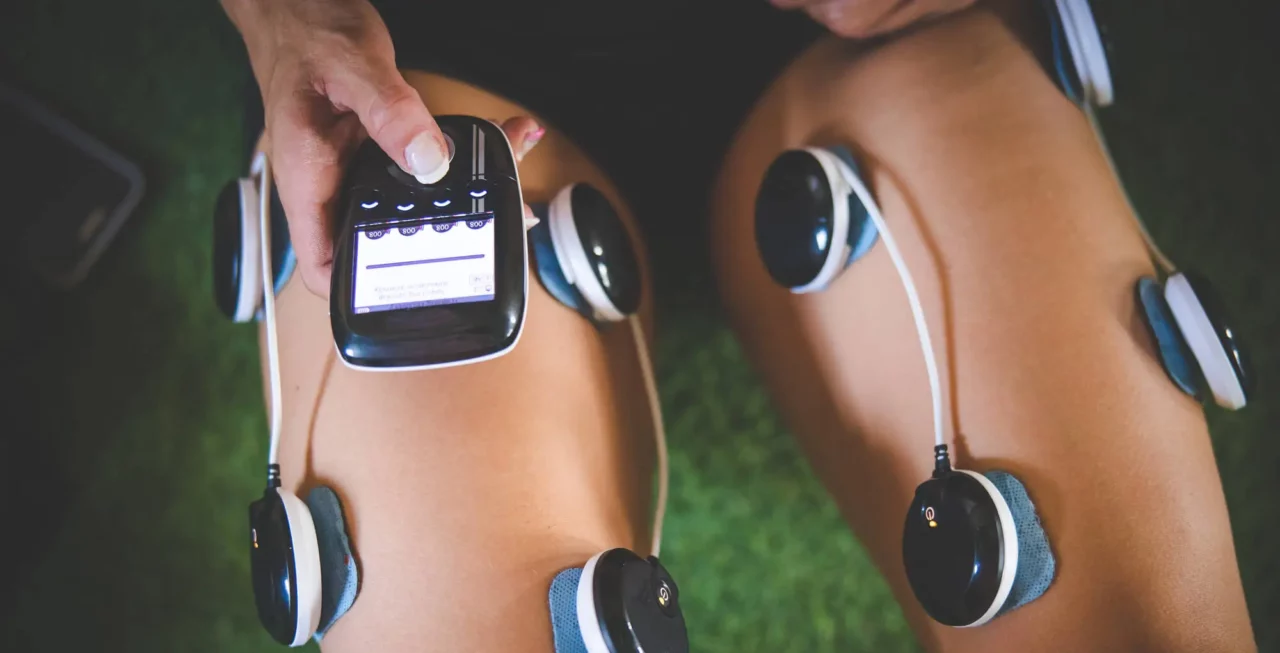
According to a 2019 study, EMS can be considered to be an affordable and efficient instrument to ease pain and speed up recovery following an athletic knee injury, such as a torn Anterior Cruciate Ligament (ACL) tear. The same study shows that EMS may be efficient in promoting the health and strength of the quadriceps muscle group after ACL repair surgery.
A 2017 study conducted on rats also shows that the use of Russian stimulation can speed up the bone regeneration process.
According to the research and case studies seen above, electrical stimulation may have analgesic – or pain-relieving – effects in people suffering from a range of conditions causing knee pain.
But the benefits of these therapies go beyond simply easing discomfort. Let’s look at these benefits below:
Additionally, by forcing the muscles to contract, e-stim combats the build-up of fluids and swelling that occurs when the muscles are still for too long (edema).
What to expect during e-stim therapy depends on the type of device used and the results you are looking to achieve. Before your first session, your healthcare provider will guide you through each step of the therapy, aftercare, and expected results.
Below, you’ll find an overview of what happens during an electrical stimulation therapy session.
Normally, electrical stimulation therapy is used as part of a broader physical therapy or rehabilitation program that aims to restore knee function, support recovery from an injury, or reduce pain.
In these cases, the therapy is administered by a professional using medical-grade devices. You’ll be instructed on how many sessions are needed to achieve the desired results and on the best type of e-stim for your needs. Below, we’ll look at what happens during and after the therapy.
Note: Some TENS units are also available as over-the-counter devices. Although these devices allow you to self-administer the treatment, they come with reduced electrical power. The limited strength and frequency of the electrical pulses may not be enough to improve your knee pain.
Most electrical stimulation units are battery-powered devices attached to electrodes via thin wires. The electrodes are adhesive pads that are temporarily placed on the skin and can be easily removed at the end of the session.
During the therapy, mild pulses of electrical current are delivered to the area receiving treatment via the electrodes. With the supervision of a professional, the electrical current is adjusted to provide powerful – but not painful – stimulation.
Note: While e-stim may cause tingling and “pin and needles” sensations, it should not be painful. Tell your doctor immediately if you are experiencing pain.
Some electrical stimulation therapies – such as the ones used to address knee pain deriving from arthritis and joint conditions – are passive, meaning that you will relax during treatment. Oppositely, when e-stim is used to improve muscle mass, prevent muscle atrophy, or retrain your muscles to contract properly, you may need to engage in movements such as walking.
Let’s look at the e-stim therapy process in more detail below.
After determining the area of pain and what’s causing it, your healthcare provider will start the therapy by placing the electrodes around the knee. Usually, two or four pads are placed in the area around the knee, on the front, back, and sides of the joint.
The most common placement for the electrodes is illustrated below:
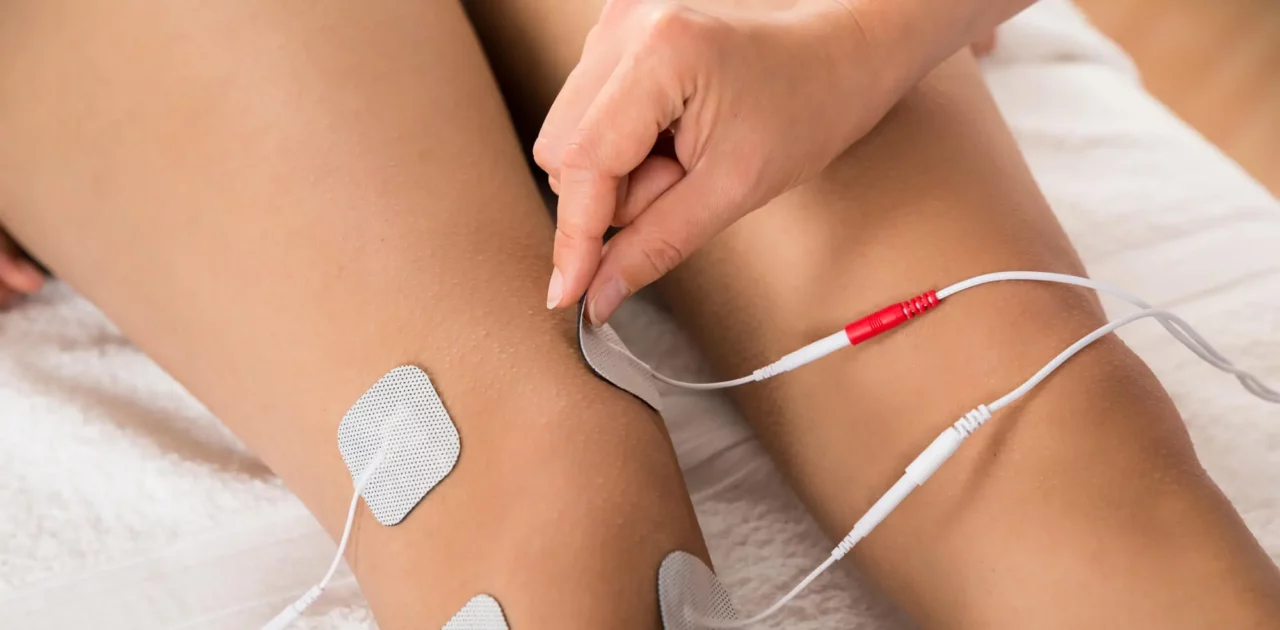
Your doctor will determine how many pads you need and where they should be placed. However, usually, the pads’ placement is determined by where you feel pain. A few rules include:
If the therapy is administered within clinical settings, your healthcare provider will place the electrodes for you. If you decide to use an at-home TENS unit, you may follow the instructions of your doctor to correctly place the electrodes.
You should not place the electrodes on:
The pads should be applied to clean and dry skin. They should not touch each other or any metal object, such as a belt buckle.
Once the electrodes are correctly placed around the knee, the electrical stimulation device is turned on on the lower setting. The electrical pulses are fine-tuned based on the following parameters:
Low-intensity pulses will cause you to experience tingling and “pin and needles” sensations. These sensations are known as paresthesia and, while they may feel strong, they should be comfortable and not painful.
The therapy provider will gradually increase the intensity and frequency of the electrical pulses to cause sensations that are closer to your pain threshold. If the treatment is administered to build or maintain muscle mass, you may also experience mild muscle twitches and contractions.
Each electrical stimulation therapy can last between 5 and 15 minutes, depending on which condition you are aiming to treat and what type of therapy is used. At-home TENS units can be used for 30-60 minutes up to four times a day.
According to a 2003 study, the best results among people with osteoarthritic knee pain were achieved when electrical stimulation was used for 40 to 60 minutes, 5 days a week for 2 weeks.
Additionally, a 2019 study shows that NMES, when administered for 20 minutes 3 times a day for 6 weeks, can help patients regain knee function after total knee replacement surgery.
The effects of electrical stimulation can last between 5 minutes and 18 hours.
As a non-invasive therapy, electrical stimulation does not involve long periods of downtime or recovery. However, your doctor may recommend aftercare instructions that can improve the therapy’s results and prevent injuries.
Some guidelines include:
When administered by a professional and following a health exam, electrical stimulation is considered to be safe.
Although minor, some risks you may run when choosing this therapy include:
A study conducted in 2015 also shows that the chronic use of low-frequency electrical stimulation can contribute to the accumulation of waste materials in the muscle fibers, which can lead to muscle fatigue and damage.
At-home TENS units are considered safe because of the low strength of the electrical pulses they deliver. Nonetheless, you should apply the electrodes with care to avoid sensitive areas such as the genitals and abdomen. Electric stimulation devices should not be used when bathing or showering.
As seen above, electrical stimulation can be a valid pain management option for a range of knee conditions. However, just like any other treatment, this type of therapy isn’t equally suitable or safe for everyone.
In particular, e-stim is contraindicated for:
You should also avoid using electrical stimulation to address pain that has not been properly diagnosed.
Chronic or acute knee pain can inhibit activities that are part of a normal and fulfilling life, such as climbing stairs, enjoying walks outdoors, taking care of yourself, cooking, or moving around your home. But taking pain medications daily or undergoing a total knee arthroplasty are no longer the only options to manage your pain.
Electrical stimulation can provide long-lasting relief from pain without drugs or surgery. With Neurofunctional Pain Management, you can access ad hoc e-stim and electroanalgesia programs designed around your needs.
About the Author
Will is a healthcare executive, innovator, entrepreneur, inventor, and writer with a wide range of experience in the medical field. Will has multiple degrees in a wide range of subjects that give depth to his capability as an entrepreneur and capacity to operate as an innovative healthcare executive.
Share on Social Media




You can see how this popup was set up in our step-by-step guide: https://wppopupmaker.com/guides/auto-opening-announcement-popups/
You can see how this popup was set up in our step-by-step guide: https://wppopupmaker.com/guides/auto-opening-announcement-popups/
Neurofunctional Pain Management Overview
Symptoms
Conditions Treated
Treatments
Articles by Category
Locations
Colorado
Wisconsin
Georgia
Hiram
Lawrenceville
Marietta
Powder Springs
Texas
Waco
Victoria
Illinois
Buffalo Grove
New Lenox
St. Charles
Arizona
Tucson
Waddell
Arlington
Avondale
Buckeye
Superior
Mesa
Palo Verde
Morristown
Tempe
Chandler
Anthem
Eloy
Florence
Fort McDowell
Phoenix
El Mirage
Coolidge
Gilbert
Arizona City
Casa Grande
Casa Blanca
Aguila
Sacaton
Apache Junction
Kearny
Stanfield
Goodyear
Litchfield Park
Alabama
Arkansas
California
Florida
Idaho
Indiana
Iowa
Kansas
Louisiana
Maryland
Michigan
Rhode Island
Minnesota
Mississippi
Nevada
New Jersey
New Mexico
North Carolina
Ohio
Pennsylvania
South Dakota
Tennessee
Utah
Virginia
Washington

